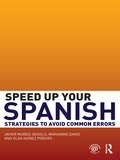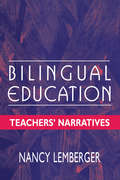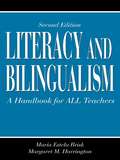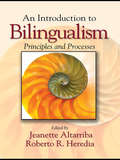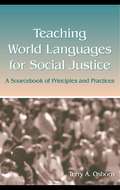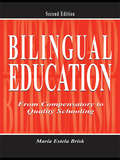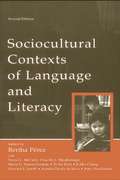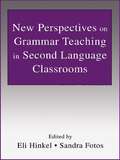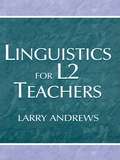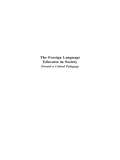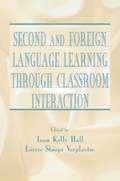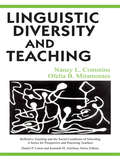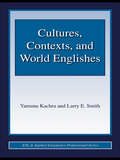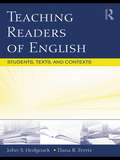- Table View
- List View
Speed Up Your Spanish: Strategies to Avoid Common Errors
by Javier Muñoz-Basols Marianne David Olga Núñez Piñeiro‘Excellent book. The chapters put together and systematise a lot of material that is often taught in an anecdotal or haphazard sort of way, if at all. Students will learn a great deal from the book and have their confidence in using Spanish considerably boosted as a result.’ – Jonathan Thacker, Merton College, University of Oxford, UK ‘An invaluable, highly original and methodically sound approach to correcting and eliminating common, yet difficult-to-eliminate errors.’ – Manuel Delgado, Bucknell University, USA ‘The user-friendly format and page layout makes Speed Up Your Spanish a highly practical reference source for students and teachers.’– Ma Victoria García Serrano, University of Pennsylvania, USA False friends, idiomatic expressions, gender and capitalization are just some of the areas that cause confusion for students of Spanish. Learning how to avoid the common errors that arise repeatedly in these areas is an essential step for successful language learning. Speed Up Your Spanish is a unique and innovative resource that identifies and explains such errors, thereby enabling students of Spanish to learn from their mistakes while enhancing their understanding of the Spanish language. Each of the nine chapters focuses on a grammatical category where English speakers typically make mistakes in Spanish. Each chapter is divided into sections that classify the concepts and errors into subcategories. Full explanations are provided throughout with clear, comprehensive examples and exercises to help the learner gain an in-depth understanding of Spanish grammar and usage. Key features: carefully selected grammar topics and examples based on the most commonly made errors exercises throughout to reinforce learning shortcuts and mnemonic devices providing vital learning strategies a Companion Website available at www.speedupyourspanish.com providing supplementary exercises as well as audio files. Suitable both for classroom use or self-study, Speed Up Your Spanish is the ideal resource for all intermediate learners of Spanish wishing to refine their language skills. Javier Muñoz-Basols is an Instructor in Spanish at the University of Oxford. Marianne David teaches Spanish at the Trinity School in New York. Olga Núñez Piñeiro is Senior Lecturer in Spanish at the University of Westminster.
Bilingual Education: Teachers' Narratives
by Nancy LembergerThis book grew out of the joys and challenges the author experienced as a Spanish/English bilingual teacher of culturally and linguistically diverse students. It tells what it is like to be a bilingual teacher. As a result, it helps other teachers and prospective teachers understand the complex nature of bilingual teaching, shares some successful teaching strategies that other teachers have used, and encourages teachers to find their own solutions despite limited support. The book is structured in three parts. The introduction explains how the book evolved, defines its relation to other qualitative research, and offers suggestions for how to use the book. The second part consists of eight bilingual teachers' stories that provide a glimpse of them as people, their schools and programs, their successes and struggles, and their solutions and coping mechanisms within their contexts. It concludes with a discussion chapter that looks at the teachers' collective strengths and struggles comparatively, connecting these to broader issues. The final section presents bilingual education resources -- useful information for practitioners. This includes foundation texts on the theories and practices of bilingual education, demographic information, a glossary of bilingual education terms, listings of curricula, tests, and literature mentioned by the teachers, and professional network sources.
Bilingual Education: Teachers' Narratives
by Nancy LembergerThis book grew out of the joys and challenges the author experienced as a Spanish/English bilingual teacher of culturally and linguistically diverse students. It tells what it is like to be a bilingual teacher. As a result, it helps other teachers and prospective teachers understand the complex nature of bilingual teaching, shares some successful teaching strategies that other teachers have used, and encourages teachers to find their own solutions despite limited support. The book is structured in three parts. The introduction explains how the book evolved, defines its relation to other qualitative research, and offers suggestions for how to use the book. The second part consists of eight bilingual teachers' stories that provide a glimpse of them as people, their schools and programs, their successes and struggles, and their solutions and coping mechanisms within their contexts. It concludes with a discussion chapter that looks at the teachers' collective strengths and struggles comparatively, connecting these to broader issues. The final section presents bilingual education resources -- useful information for practitioners. This includes foundation texts on the theories and practices of bilingual education, demographic information, a glossary of bilingual education terms, listings of curricula, tests, and literature mentioned by the teachers, and professional network sources.
Literacy and Bilingualism: A Handbook for ALL Teachers
by Maria Estela Brisk Margaret M. HarringtonThis handbook applies proven techniques, derived from bilingual/bicultural classrooms, to teaching literacy in the twenty-first century. Its goal is to help teachers increase their understanding of bilingual learners in order to maximize instruction. Teachers can use this handbook to expand their understanding of literacy and bilingualism; implement literacy approaches and assess students’ development; and learn through reflection. Practical, flexible format and content. Complete and straightforward instructions, illustrated by case studies, allow teachers to use the strategies in this handbook on their own or in teacher-led study groups. They can select from the variety of approaches the ones which best match their students’ needs and their own teaching style. Student-centered focus. All of the approaches share characteristics that help motivate students of varying language abilities to develop literacy. Field-tested approaches. The approaches have been modified and tested with bilingual students of different ages and language backgrounds in bilingual, ESL, mainstream, special education, and deaf education classes ranging from preschool through high school. New in the Second Edition: *five new approaches with their corresponding classroom implementation;*additional information in each introduction addressing its theme;*new material on issues of language, culture, and literacy development of students completely new to the English language; and*annotated bibliographies with sample books to support literacy within language and content area classes. Literacy and Bilingualism is intended for a broad audience of teachers in any type of classroom where bilingualism plays a role, and is an excellent text for preservice and inservice courses that prepare teachers to work with English language learners.
Literacy and Bilingualism: A Handbook for ALL Teachers
by Maria Estela Brisk Margaret M. HarringtonThis handbook applies proven techniques, derived from bilingual/bicultural classrooms, to teaching literacy in the twenty-first century. Its goal is to help teachers increase their understanding of bilingual learners in order to maximize instruction. Teachers can use this handbook to expand their understanding of literacy and bilingualism; implement literacy approaches and assess students’ development; and learn through reflection. Practical, flexible format and content. Complete and straightforward instructions, illustrated by case studies, allow teachers to use the strategies in this handbook on their own or in teacher-led study groups. They can select from the variety of approaches the ones which best match their students’ needs and their own teaching style. Student-centered focus. All of the approaches share characteristics that help motivate students of varying language abilities to develop literacy. Field-tested approaches. The approaches have been modified and tested with bilingual students of different ages and language backgrounds in bilingual, ESL, mainstream, special education, and deaf education classes ranging from preschool through high school. New in the Second Edition: *five new approaches with their corresponding classroom implementation;*additional information in each introduction addressing its theme;*new material on issues of language, culture, and literacy development of students completely new to the English language; and*annotated bibliographies with sample books to support literacy within language and content area classes. Literacy and Bilingualism is intended for a broad audience of teachers in any type of classroom where bilingualism plays a role, and is an excellent text for preservice and inservice courses that prepare teachers to work with English language learners.
An Introduction to Bilingualism: Principles and Processes
by Jeanette Altarriba Roberto R. HerediaThis important text provides a general overview of the methods and theories used in the broad domain of bilingualism. The unique interdisciplinary approach, which is reflected in the various topics covered, gives students a global picture of the field. Topics range from early childhood intellectual development to educational and social-cognitive challenges to the maturing bilingual brain. Important developing areas such as cognitive aging, creativity, the social and cultural context perspective, communication disorders and sentence processing are also covered within the volume. This text is aimed towards undergraduate courses and graduate courses in psycholinguistics, especially those with an emphasis on bilingualism or second language learning.
An Introduction to Bilingualism: Principles and Processes
by Jeanette Altarriba Roberto R. HerediaThis important text provides a general overview of the methods and theories used in the broad domain of bilingualism. The unique interdisciplinary approach, which is reflected in the various topics covered, gives students a global picture of the field. Topics range from early childhood intellectual development to educational and social-cognitive challenges to the maturing bilingual brain. Important developing areas such as cognitive aging, creativity, the social and cultural context perspective, communication disorders and sentence processing are also covered within the volume. This text is aimed towards undergraduate courses and graduate courses in psycholinguistics, especially those with an emphasis on bilingualism or second language learning.
Teaching World Languages for Social Justice: A Sourcebook of Principles and Practices
by Terry A. OsbornTeaching World Languages for Social Justice: A Sourcebook of Principles and Practices offers principles based on theory, and innovative concepts, approaches, and practices illustrated through concrete examples, for promoting social justice and developing a critical praxis in foreign language classrooms in the U.S. and in wider world language communities. For educators seeking to translate these ideals into classroom practice in an environment dominated by the current standards movement and accountability measures, the critical insights on language education offered in this text will be widely welcomed.The text is designed as a sourcebook for translating theory into practice. Each chapter includes the theoretical base, guidelines for practice, discussion of the relationship to existing practices in the world language classroom, suggestions for activity development (which can be integrated into a professional portfolio), illustrative examples, questions for reflection, and additional suggested readings.Teaching World Languages for Social Justice is a primary or supplementary text for second and foreign language teaching methods courses and is equally appropriate for graduate courses in language education or educational studies.
Teaching World Languages for Social Justice: A Sourcebook of Principles and Practices
by Terry A. OsbornTeaching World Languages for Social Justice: A Sourcebook of Principles and Practices offers principles based on theory, and innovative concepts, approaches, and practices illustrated through concrete examples, for promoting social justice and developing a critical praxis in foreign language classrooms in the U.S. and in wider world language communities. For educators seeking to translate these ideals into classroom practice in an environment dominated by the current standards movement and accountability measures, the critical insights on language education offered in this text will be widely welcomed.The text is designed as a sourcebook for translating theory into practice. Each chapter includes the theoretical base, guidelines for practice, discussion of the relationship to existing practices in the world language classroom, suggestions for activity development (which can be integrated into a professional portfolio), illustrative examples, questions for reflection, and additional suggested readings.Teaching World Languages for Social Justice is a primary or supplementary text for second and foreign language teaching methods courses and is equally appropriate for graduate courses in language education or educational studies.
Bilingual Education: From Compensatory To Quality Schooling
by María Estela BriskBilingual Education: From Compensatory to Quality Schooling, Second Edition maintains its original purpose of synthesizing the research on successful bilingual education in order to demonstrate that quality bilingual education is possible and desirable.Findings from a wide range of studies are integrated to provide a clear picture of bilingual education in today's schools, and a professional understanding of the foundations and issues surrounding bilingual education programs. The recommendations offered provide a comprehensive basis for planning, developing, improving, and evaluating bilingual programs. For clarity, these recommendations are discussed with respect to the whole school, the curriculum, and the classroom, but it is stressed that they need to be applied in a holistic way because they depend on each other. All educators who work or will work with bilingual students--classroom teachers, administrators, and curricula developers--will find the information in this text essential and will appreciate the straightforward approach and easy reading style.New in the Second Edition:*A new Chapter 1, Pursuing Successful Schooling, includes the definition of success that frames the content of the book, and a review of how the research on bilingual education has changed.*Chapter 2, Bilingual Education Debate, is substantially revised to address major changes in demographics and legislation.*Chapter 3, Contextual and Individual Factors: Supports and Challenges, is updated to include important new research on the external and internal factors affecting learners and a new section on peers.*Chapter 4, Creating a Good School, is reorganized and updated.*Chapter 5, Creating Quality Curriculum, is updated throughout, particularly the sections on teaching content areas and assessment.*Chapter 6, Creating Quality Instruction, includes extensive new material in the sections on "Teaching English and In English" and "Teaching Students with Limited Schooling."*Chapter 7, Beyond the Debate, has an extensive new section describing and analyzing how the framework for quality education can be used as a guide to help create a new program.
Bilingual Education: From Compensatory To Quality Schooling
by María Estela BriskBilingual Education: From Compensatory to Quality Schooling, Second Edition maintains its original purpose of synthesizing the research on successful bilingual education in order to demonstrate that quality bilingual education is possible and desirable.Findings from a wide range of studies are integrated to provide a clear picture of bilingual education in today's schools, and a professional understanding of the foundations and issues surrounding bilingual education programs. The recommendations offered provide a comprehensive basis for planning, developing, improving, and evaluating bilingual programs. For clarity, these recommendations are discussed with respect to the whole school, the curriculum, and the classroom, but it is stressed that they need to be applied in a holistic way because they depend on each other. All educators who work or will work with bilingual students--classroom teachers, administrators, and curricula developers--will find the information in this text essential and will appreciate the straightforward approach and easy reading style.New in the Second Edition:*A new Chapter 1, Pursuing Successful Schooling, includes the definition of success that frames the content of the book, and a review of how the research on bilingual education has changed.*Chapter 2, Bilingual Education Debate, is substantially revised to address major changes in demographics and legislation.*Chapter 3, Contextual and Individual Factors: Supports and Challenges, is updated to include important new research on the external and internal factors affecting learners and a new section on peers.*Chapter 4, Creating a Good School, is reorganized and updated.*Chapter 5, Creating Quality Curriculum, is updated throughout, particularly the sections on teaching content areas and assessment.*Chapter 6, Creating Quality Instruction, includes extensive new material in the sections on "Teaching English and In English" and "Teaching Students with Limited Schooling."*Chapter 7, Beyond the Debate, has an extensive new section describing and analyzing how the framework for quality education can be used as a guide to help create a new program.
Sociocultural Contexts of Language and Literacy
by Teresa L. McCarty Lucille J. Watahomigie To Thi Dien Bertha Perez Mar¡a E. Torres-GuzmanSociocultural Contexts of Language and Literacy, Second Edition engages prospective and in-service teachers in learning about linguistically and culturally diverse students, and in using this knowledge to enrich literacy learning in classrooms and communities. The text is grounded in current research and theory that integrate sociocultural and constructivist concepts and perspectives and provide a framework teachers can use to develop strategies for teaching reading, writing, and thinking to diverse students. The focus on English literacy development does not imply advocacy for "English only" or ESL as the primary mode of literacy instruction. Rather, the authors take the position that learners need to develop literacy in their native language and that the concepts and skills learned in developing the native language create a foundation of strength from which students can develop English literacy. Part I introduces relevant research and language learning theories. Part II provides research reviews and information about literacy learning within specific culturally and linguistically diverse communities. The chapters in Part III challenge the reader to view the multiple social, intellectual, cultural, and language differences children bring to the classroom as an opportunity for learning and building on the diversity among students. Activities and suggested readings at the end of each chapter involve readers in reflection, observation, meaning making, and the construction of application processes for their new understandings. New in the Second Edition:*updated research and theory on multilingual and second language literacy;*a focus on the interpretation of these research findings to make them useful for teachers and teacher educators in understanding and articulating the research bases for literacy practices; *attention to current intensely debated issues, such as standards, the phonics movement, and high-stakes testing; and*new activities and suggested readings.
Sociocultural Contexts of Language and Literacy
by Teresa L. McCarty Lucille J. Watahomigie To Thi Dien Bertha Perez Mar¡a E. Torres-GuzmanSociocultural Contexts of Language and Literacy, Second Edition engages prospective and in-service teachers in learning about linguistically and culturally diverse students, and in using this knowledge to enrich literacy learning in classrooms and communities. The text is grounded in current research and theory that integrate sociocultural and constructivist concepts and perspectives and provide a framework teachers can use to develop strategies for teaching reading, writing, and thinking to diverse students. The focus on English literacy development does not imply advocacy for "English only" or ESL as the primary mode of literacy instruction. Rather, the authors take the position that learners need to develop literacy in their native language and that the concepts and skills learned in developing the native language create a foundation of strength from which students can develop English literacy. Part I introduces relevant research and language learning theories. Part II provides research reviews and information about literacy learning within specific culturally and linguistically diverse communities. The chapters in Part III challenge the reader to view the multiple social, intellectual, cultural, and language differences children bring to the classroom as an opportunity for learning and building on the diversity among students. Activities and suggested readings at the end of each chapter involve readers in reflection, observation, meaning making, and the construction of application processes for their new understandings. New in the Second Edition:*updated research and theory on multilingual and second language literacy;*a focus on the interpretation of these research findings to make them useful for teachers and teacher educators in understanding and articulating the research bases for literacy practices; *attention to current intensely debated issues, such as standards, the phonics movement, and high-stakes testing; and*new activities and suggested readings.
New Perspectives on Grammar Teaching in Second Language Classrooms
by Eli Hinkel Sandra FotosNew Perspectives on Grammar Teaching in Second Language Classrooms brings together various approaches to the contextualized teaching of grammar and communicative skills as integrated components of second language instruction. Its purpose is to show from both theoretical and practical perspectives that grammar teaching can be made productive and useful in ESL and EFL classrooms. In this text: *First-rate scholars approach the teaching of grammar from multiple complementary perspectives, providing an original, comprehensive treatment of the topic. *Discourse analysis and research data are used to address such pedagogical areas as grammatical and lexical development in speaking, listening, reading, and writing. *The communicative perspective on ESL and EFL instruction that is presented provides ways for learners to enhance their production skills, whereas the meaning-based grammar instruction can supplement and strengthen current methodology with a communicative focus. This volume is intended as a foundational text for second language grammar pedagogy courses at the advanced undergraduate and master's levels.
New Perspectives on Grammar Teaching in Second Language Classrooms
by Eli Hinkel Sandra FotosNew Perspectives on Grammar Teaching in Second Language Classrooms brings together various approaches to the contextualized teaching of grammar and communicative skills as integrated components of second language instruction. Its purpose is to show from both theoretical and practical perspectives that grammar teaching can be made productive and useful in ESL and EFL classrooms. In this text: *First-rate scholars approach the teaching of grammar from multiple complementary perspectives, providing an original, comprehensive treatment of the topic. *Discourse analysis and research data are used to address such pedagogical areas as grammatical and lexical development in speaking, listening, reading, and writing. *The communicative perspective on ESL and EFL instruction that is presented provides ways for learners to enhance their production skills, whereas the meaning-based grammar instruction can supplement and strengthen current methodology with a communicative focus. This volume is intended as a foundational text for second language grammar pedagogy courses at the advanced undergraduate and master's levels.
Linguistics for L2 Teachers
by Larry AndrewsLinguistics for L2 Teachers is designed to help bilingual and ESL teachers better understand how and why the English language works, and to broaden their abilities to help their students learn about the various functions of English in the real world. It is not a complete curriculum in English linguistics, but rather, a foundation from which teachers can continue to grow and to teach with greater confidence. The reader-friendly, conversational style makes the concepts easily accessible to preservice and in-service teachers who have little or no previous experience in language study. This textbook: * explains various aspects of English using non-technical terminology; * goes beyond the study of grammar to examine the functions of language, not just its form; * presents language applications in L2 classrooms; and * clearly delineates the significance of chapter topics for L2 teachers and students. Each chapter includes prereading activities to enhance the reader's comprehension; postreading activities to expand and elaborate the concepts; and interactive "Be A Linguist" activities to help readers think in ways similar to the ways linguists think and to provide opportunities to apply ideas explained within the chapter. Intended for all teachers of students for whom English is a new language, this text will help them be better prepared to meet the important challenges and questions they encounter in their classrooms.
Linguistics for L2 Teachers
by Larry AndrewsLinguistics for L2 Teachers is designed to help bilingual and ESL teachers better understand how and why the English language works, and to broaden their abilities to help their students learn about the various functions of English in the real world. It is not a complete curriculum in English linguistics, but rather, a foundation from which teachers can continue to grow and to teach with greater confidence. The reader-friendly, conversational style makes the concepts easily accessible to preservice and in-service teachers who have little or no previous experience in language study. This textbook: * explains various aspects of English using non-technical terminology; * goes beyond the study of grammar to examine the functions of language, not just its form; * presents language applications in L2 classrooms; and * clearly delineates the significance of chapter topics for L2 teachers and students. Each chapter includes prereading activities to enhance the reader's comprehension; postreading activities to expand and elaborate the concepts; and interactive "Be A Linguist" activities to help readers think in ways similar to the ways linguists think and to provide opportunities to apply ideas explained within the chapter. Intended for all teachers of students for whom English is a new language, this text will help them be better prepared to meet the important challenges and questions they encounter in their classrooms.
The Foreign Language Educator in Society: Toward A Critical Pedagogy
by Timothy G. Reagan Terry A. OsbornThis text brings together two significant domains of educational practice: foreign language education and critical pedagogy--linking them in a way that can help foreign language educators develop a critical awareness of the nature, purposes, and challenges facing foreign language pedagogy. Unique among texts in the field, this is the first to deal explicitly with the social, political, ideological, and economic aspects of language, language learning, and language teaching in our society and to connect the practice of foreign language education with these critical, and crucial, aspects of language and language use. The Foreign Language Educator in Society: Toward A Critical Pedagogy: *emphasizes what teachers and future teachers of foreign languages in this country ought to know and understand about language-- language attitudes, practices, rights, and policy-- and related issues; *focuses on helping students to move beyond pragmatic pedagogical concerns to the social and political concerns relevant to their teaching; and *provides students with the opportunity to develop critical perspectives on the central facets of the language education process. Intended for foreign language education programs at both basic and advanced levels, as well as courses in critical pedagogy, critical language awareness, sociolinguistics, and social and cultural foundations of education, the text provides helpful pedagogical features to direct the reader in applying the content of each chapter to his or her own context.
The Foreign Language Educator in Society: Toward A Critical Pedagogy
by Timothy G. Reagan Terry A. OsbornThis text brings together two significant domains of educational practice: foreign language education and critical pedagogy--linking them in a way that can help foreign language educators develop a critical awareness of the nature, purposes, and challenges facing foreign language pedagogy. Unique among texts in the field, this is the first to deal explicitly with the social, political, ideological, and economic aspects of language, language learning, and language teaching in our society and to connect the practice of foreign language education with these critical, and crucial, aspects of language and language use. The Foreign Language Educator in Society: Toward A Critical Pedagogy: *emphasizes what teachers and future teachers of foreign languages in this country ought to know and understand about language-- language attitudes, practices, rights, and policy-- and related issues; *focuses on helping students to move beyond pragmatic pedagogical concerns to the social and political concerns relevant to their teaching; and *provides students with the opportunity to develop critical perspectives on the central facets of the language education process. Intended for foreign language education programs at both basic and advanced levels, as well as courses in critical pedagogy, critical language awareness, sociolinguistics, and social and cultural foundations of education, the text provides helpful pedagogical features to direct the reader in applying the content of each chapter to his or her own context.
Second and Foreign Language Learning Through Classroom Interaction
by Joan Kelly Hall Lorrie Stoops VerplaetseThis volume brings together the current theoretical interest in reconceptualizing second and foreign language learning from a sociocultural perspective on language and learning, with practical concerns about second and foreign language pedagogy. It presents a set of studies whose focus is on the empirical description of particular practices constructed in classroom interaction that promote the learning of a second or foreign language. The authors examine in detail the processes by which the learning of additional languages is accomplished in the interaction of a variety of classrooms and in a variety of languages. Not only will the findings from the studies reported in this volume help to lay a foundation for the development of a more expansive, sociocultural model of second and foreign language learning, but on a more practical level they will help language educators in creating a set of principles for identifying and sustaining classroom interactional practices that foster additional language development. The volume is distinguished in three ways: * Following a Vygotskyan perspective on development, the studies assume that language learning is a fundamentally pragmatic enterprise, intrinsically linked to language use. This breaks from a more traditional understanding of second and foreign language learning, which has viewed learning and use as two distinct phenomena. The importance of classroom interaction to additional language development is foregrounded. * The investigations reported in this book are distinguished by their methodological approach. Because language learning is assumed to be a situated, context-sensitive, and dynamic process, the studies do not rely on traditional experimental methods for collecting and analyzing data, but rather, they involve primarily the use of ethnographic and discourse analytic methods. * The studies focus on interactional practices that promote second and foreign language learning. Although a great deal of research has examined first language learning in classrooms from a sociocultural perspective, little has looked at second and foreign language classrooms from such a perspective. Thus there is a strong need for this volume of studies addressing this area of research. Researchers, teacher educators, and graduate students across the fields of second and foreign language learning, applied linguistics, and language education will find this book informative and relevant. Because of the programmatic implications arising from the studies, it will also appeal to teacher educators and teachers of second and foreign languages from the elementary to the university levels.
Second and Foreign Language Learning Through Classroom Interaction
by Joan Kelly Hall Lorrie Stoops VerplaetseThis volume brings together the current theoretical interest in reconceptualizing second and foreign language learning from a sociocultural perspective on language and learning, with practical concerns about second and foreign language pedagogy. It presents a set of studies whose focus is on the empirical description of particular practices constructed in classroom interaction that promote the learning of a second or foreign language. The authors examine in detail the processes by which the learning of additional languages is accomplished in the interaction of a variety of classrooms and in a variety of languages. Not only will the findings from the studies reported in this volume help to lay a foundation for the development of a more expansive, sociocultural model of second and foreign language learning, but on a more practical level they will help language educators in creating a set of principles for identifying and sustaining classroom interactional practices that foster additional language development. The volume is distinguished in three ways: * Following a Vygotskyan perspective on development, the studies assume that language learning is a fundamentally pragmatic enterprise, intrinsically linked to language use. This breaks from a more traditional understanding of second and foreign language learning, which has viewed learning and use as two distinct phenomena. The importance of classroom interaction to additional language development is foregrounded. * The investigations reported in this book are distinguished by their methodological approach. Because language learning is assumed to be a situated, context-sensitive, and dynamic process, the studies do not rely on traditional experimental methods for collecting and analyzing data, but rather, they involve primarily the use of ethnographic and discourse analytic methods. * The studies focus on interactional practices that promote second and foreign language learning. Although a great deal of research has examined first language learning in classrooms from a sociocultural perspective, little has looked at second and foreign language classrooms from such a perspective. Thus there is a strong need for this volume of studies addressing this area of research. Researchers, teacher educators, and graduate students across the fields of second and foreign language learning, applied linguistics, and language education will find this book informative and relevant. Because of the programmatic implications arising from the studies, it will also appeal to teacher educators and teachers of second and foreign languages from the elementary to the university levels.
Linguistic Diversity and Teaching
by Nancy L. Commins Ofelia B. MiramontesLinguistic Diversity and Teaching raises questions and provides a context for reflection regarding the complex issues surrounding new English learners in the schools. These issues exist within a highly charged political climate and involve not only language, but also culture, class, ethnicity, and the persistent inequities that characterize our educational system. The text addresses these issues through conversations among experts, practitioners, and readers that are informed by representative case studies and by a range of theoretical approaches. It is designed to engage readers in beginning to evolve their own practical theories, to help them explore and perhaps modify some basic beliefs and assumptions, and to become acquainted with other points of view. Throughout, readers are encouraged to interact with the text and to develop their own perspective on the issue of linguistic diversity and teaching. This is the fourth volume in Reflective Teaching and the Social Conditions of Schooling: A Series for Prospective and Practicing Teachers, edited by Daniel P. Liston and Kenneth M. Zeichner. It follows the same format as previous volumes in the series.*Part I includes four cases dealing with different aspects of the impacts of the changing demographics of public schools. Each case is followed by space for readers to write their own reactions and reflections, and a set of reactions to the cases written by prospective and practicing teachers, administrators, and professors. *Part II presents three public arguments representing very different views about linguistic diversity: in public schools, English should be the only language of instruction; all children should receive instruction in both their first language and English; planning for instruction should be based not on absolutes, but on what is realistically possible in particular settings.*Part III offers the authors' own interpretations of the issues raised throughout the text, outlines a number of ways in which teachers can continue to explore these topics, and includes exercises for further reflection. A glossary and annotated bibliography are provided.This text is pertinent for all prospective and practicing teachers at any stage of their training. It can be used in any undergraduate or graduate course that addresses issues of language diversity and teaching.
Cultures, Contexts, and World Englishes
by Yamuna Kachru Larry E. SmithThis volume aims to familiarize readers with the varieties of world Englishes used across cultures and to create awareness of some of the linguistic and socially relevant contexts and functions that have given rise to them. It emphasizes that effective communication among users of different Englishes requires awareness of the varieties in use and their cultural, social, and ideational functions. Cultures, Contexts and World Englishes: demonstrates the rich results of integrating theory, methodology and application features critical and detailed discussion of the sociolinguistics of English in the globalized world gives equal emphasis to grammar and pragmatics of variation and to uses of Englishes in spoken and written modes in major English-using regions of the world. Each chapter includes suggestions for further reading and challenging discussion questions and appropriate research projects designed to enhance the usefulness of this volume in courses such as world Englishes, English in the Global Context, Sociolinguistics, Critical Applied Linguistics, Language Contact and Convergence, Ethnography of Communication, and Crosscultural Communication.
Cultures, Contexts, and World Englishes
by Yamuna Kachru Larry E. SmithThis volume aims to familiarize readers with the varieties of world Englishes used across cultures and to create awareness of some of the linguistic and socially relevant contexts and functions that have given rise to them. It emphasizes that effective communication among users of different Englishes requires awareness of the varieties in use and their cultural, social, and ideational functions. Cultures, Contexts and World Englishes: demonstrates the rich results of integrating theory, methodology and application features critical and detailed discussion of the sociolinguistics of English in the globalized world gives equal emphasis to grammar and pragmatics of variation and to uses of Englishes in spoken and written modes in major English-using regions of the world. Each chapter includes suggestions for further reading and challenging discussion questions and appropriate research projects designed to enhance the usefulness of this volume in courses such as world Englishes, English in the Global Context, Sociolinguistics, Critical Applied Linguistics, Language Contact and Convergence, Ethnography of Communication, and Crosscultural Communication.
Teaching Readers of English: Students, Texts, and Contexts
by John Hedgcock Dana R. FerrisA comprehensive manual for pre- and in-service ESL and EFL educators, this frontline text balances insights from current reading theory and research with highly practical, field-tested strategies for teaching and assessing L2 reading in secondary and post-secondary contexts. Teaching Readers of English: provides a through yet accessible survey of L2 reading theory and research addresses the unique cognitive and socioeducational challenges encountered by L2 readers covers the features of L2 texts that teachers of reading must understand acquaints readers with methods for designing reading courses, selecting curricular materials, and planning instruction explores the essential role of systematic vocabulary development in teaching L2 literacy includes practical methods for assessing L2 students’ proficiency, achievement, and progress in the classroom. Pedagogical features in each chapter include questions for reflection, further reading and resources, reflection and review questions, and application activities.
